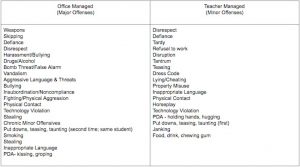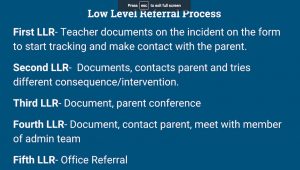Last year, my boss (@taylortiffn0826) sent Ms. Douglas (@najaelliott) and I a large file that contained some progressive discipline documents. There were presentations, statistics, flow maps, research, etc., and to make things short, she said, “You guys look at this and see what we can do with it.” That was it. No specifics on what to pull or what to discard. She told us what to do…”See what we can do with this.” That meant that there are some great things in here, and I know that you two can figure out how this can work for us.
Dr. Taylor tasked us with trying to discover how we could improve our discipline data and teach students positive behaviors versus punishing the children for acting inappropriately. We had discussions, pulled additional research, talked through some issues, and tried to see what we could do to make the improvements. After a few days of processing the information and thinking through some of the issues, we created the Low Level Referral process, where we would work collectively with our stakeholders to change student behavior. One thing was for sure; we would need the help of everyone, and there was no possible way we could make it happen without everyone being on board.
 The first thing Ms. Douglas and I had to do was to help teachers determine the difference between office-managed and teacher-managed behaviors (click on the picture to magnify it). We put this out to teachers, who agreed that the more they could manage behaviors in the classroom, the more control they would have in getting students to do what was expected of them. The more power teachers could retain, the better it would be for our students in complying with directions. This was also a change for teachers, who were accustomed of sending noncompliant students to the office, but it made sense to have teachers build relationships, put out expectations, and make students rise to those expectations. I have to note here that this is one of the points we have to discuss most with others when discussing the changes we made. The questions we get most are, “How did you get teachers on board?” “How did you make people change?” Our answer is always the same. It was a team effort.
The first thing Ms. Douglas and I had to do was to help teachers determine the difference between office-managed and teacher-managed behaviors (click on the picture to magnify it). We put this out to teachers, who agreed that the more they could manage behaviors in the classroom, the more control they would have in getting students to do what was expected of them. The more power teachers could retain, the better it would be for our students in complying with directions. This was also a change for teachers, who were accustomed of sending noncompliant students to the office, but it made sense to have teachers build relationships, put out expectations, and make students rise to those expectations. I have to note here that this is one of the points we have to discuss most with others when discussing the changes we made. The questions we get most are, “How did you get teachers on board?” “How did you make people change?” Our answer is always the same. It was a team effort.
Within the first month of incorporating the low level referral process, we we able to see a decrease in behavior referrals tremendously. I can remember us thinking to ourselves, “We may have hit gold with this process!” The teachers were contacting the parents each time the child did not adhere to the rules (major or minor) and it became an expectation at our school for  students to follow the rules, no matter who the teacher was or what the expectation was. It began to reshape the way we looked at discipline, and our teachers bought in to the process because parents were coming into the school more frequently, and they were working with us to make sure the children were meeting expectations. As an administrator, I was able to look into the contact log and say, “Ms. Jane Doe, I see that the teacher contacted you on (insert date) and spoke to you about (insert whatever situation). It appears that your child is still having the same issues because he/she has now been referred to my office.” It was like magic. We thought, “Where was this process a year ago?” The students started talking, and before you could blink, we were able to see kids correcting one another by saying things like, “You better stop before you get a low level.” The culture changed from one where students were punished to one where appropriate behavior was expected.
students to follow the rules, no matter who the teacher was or what the expectation was. It began to reshape the way we looked at discipline, and our teachers bought in to the process because parents were coming into the school more frequently, and they were working with us to make sure the children were meeting expectations. As an administrator, I was able to look into the contact log and say, “Ms. Jane Doe, I see that the teacher contacted you on (insert date) and spoke to you about (insert whatever situation). It appears that your child is still having the same issues because he/she has now been referred to my office.” It was like magic. We thought, “Where was this process a year ago?” The students started talking, and before you could blink, we were able to see kids correcting one another by saying things like, “You better stop before you get a low level.” The culture changed from one where students were punished to one where appropriate behavior was expected.
We continue to reap the benefits of the work we’ve put in to get the process in place and worked out. It’s not easy, and by no means are our students perfect. One thing I know is that we are headed in the right direction, and we are shaping the lives of kids for the better. Some of these kids spend more time with us than they do with their parents. It would be a disgrace if we didn’t prepare them to be excellent citizens. After all, we’ll depend on them one day to take care of us, so why not teach the whole child. We’ll reap those benefits later as well.
Dr. G.
What I see in your process is the development of a culture where ideas are shared and valued at every level. Your principal has faith in the abilities of the staff, and you all are responding to that. It is amazing what happens when educators are treated as the professionals they are. The students are even taking ownership of their environment by correcting each other. Creating a collaborative culture like that is talked about often, but rarely executed. Congratulations on a job well done.
Thanks, Daniel. It’s about the pride we have for our school and the capacity that one has to build in everybody that’s part of the school. Teachers have a role as do students, parents, community, and leaders. When that is clear for everyone, the real work can happen. Our school is not perfect, by far, but we have established a shared culture of learning that makes educating kids a bit easier.